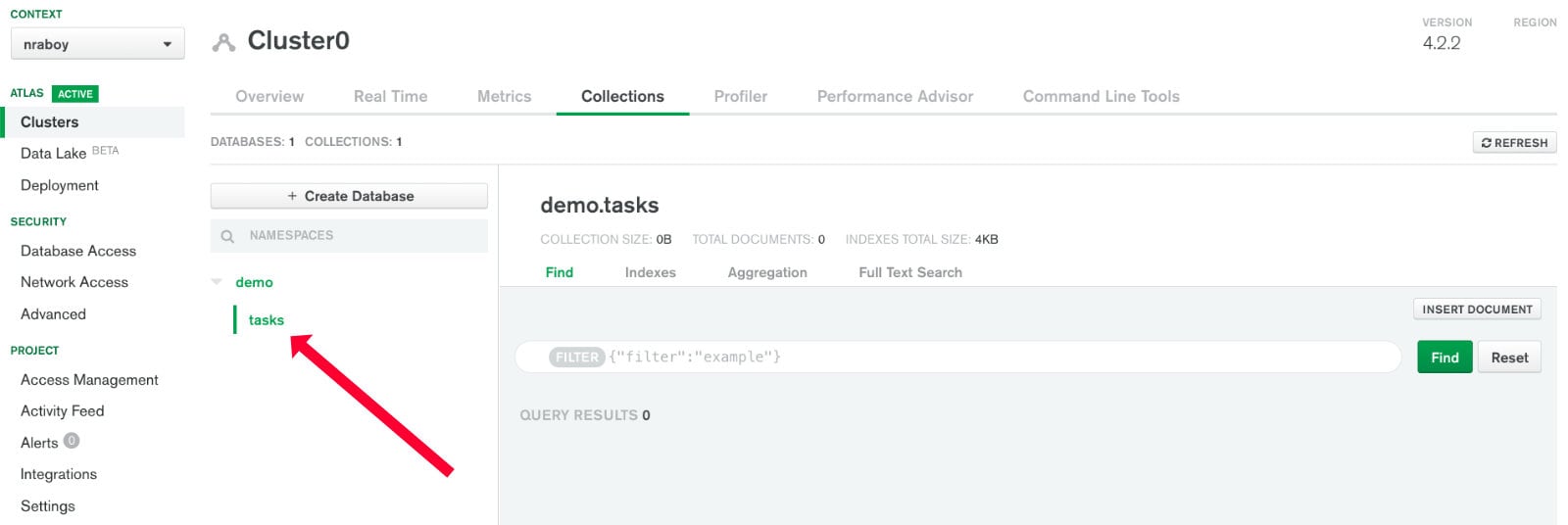
MONGODB ATLAS INSTALL
The recommended way to install it on your computer is to use the pip module as shown below: python3 -m pip install pymongo -user
MONGODB ATLAS DRIVER
For the Python programming language, PyMongo is the most popular driver available today. To be able to interact with your MongoDB Atlas cluster programmatically, you must have a MongoDB driver installed on your computer. After you do so, make a note of the string so you can use it later. It won't have your actual password, so you'll have to put it in manually. You should now be able to see your connection string. In the dialog that opens, select the Connect Your Application option and press the I'm using driver 3.6 or later button. To get it, go to the Overview tab and press the Connect button. You'll need a valid connection string to connect to your cluster from your application. Additionally, if you don't have a static IP address, it's a good idea to mark it is a temporary entry by checking the Save as temporary whitelist option. In the dialog that pops up, press the Add current IP address button to autofill the Whitelist Entry field.

Press the Add IP address button to create a new IP address entry. For now, providing the current IP address of your computer is sufficient. Next, in the IP Whitelist section, you must provide a list of IP addresses from which you'll be accessing the cluster. In the dialog that pops up, type in your desired username and password, select the Read and write to any database privilege, and press the Add User button. Configuring the Clusterīefore you start using the cluster, you'll have to provide a few security-related details, so switch to the Security tab.įirst, in the MongoDB Users section, you must create a new user for yourself by pressing the Add new user button.

MongoDB Atlas will now take about five minutes to set up your cluster. Lastly, give a meaningful name to the cluster and press the Create Cluster button. It offers 512 MB of storage space, a recent version of MongoDB with WiredTiger as the storage engine, a replica set of three nodes, and a generous 10 GB of bandwidth per week.
MONGODB ATLAS FREE
In the Cluster Tier section, select the M0 option to create your free tier cluster. Additionally, if you are using a Google Cloud VM or an Amazon EC2 instance as your development environment, do select the corresponding cloud provider first. For now, however, because we are creating a free tier cluster, make sure the region you select is one that has a free tier available. To minimize network latency, you'd ideally pick a region that's nearest to your computer. In its first section, you'll have to pick the cloud provider and region you prefer. To create one, go to its home page and press the Get started free button.Īfter you complete the short sign-up form, you'll be redirected to the cluster creation wizard. To be able to use MongoDB's cloud services, you'll need a MongoDB Atlas account. Prerequisitesīefore you proceed, make sure you have the following installed and configured on your computer:
MONGODB ATLAS HOW TO
In this tutorial, I'll show you how to create a MongoDB Atlas free tier cluster and use it in a Python application. Using Atlas's browser-based user interface, you can also intuitively configure the cluster and monitor its performance. With MongoDB Atlas, you can create a MongoDB cluster on any major cloud provider of your choice and start using that cluster in a matter of minutes. However, necessary tasks such as installing the database, tuning it to maintain optimal performance over long periods of time, and securing it tend to require a lot of skilled and dedicated effort.įortunately, there's an easier alternative: MongoDB Atlas, a fully managed, cloud version of the database.

It also supports very complex queries and fine-grained concurrency control. It's open source, easily scalable, and provides high availability. For years now, MongoDB has been the go-to NoSQL database for both individuals and enterprises building large-scale applications.


 0 kommentar(er)
0 kommentar(er)
